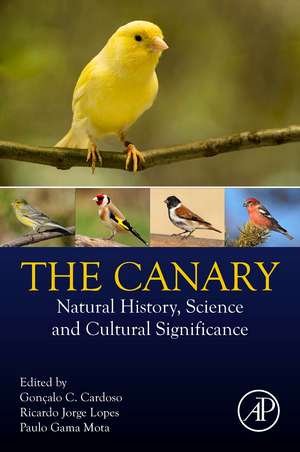The Canary: Natural History, Science and Cultural Significance
Editat de Goncalo C. Cardoso, Ricardo Jorge Lopes, Paulo Gama Motaen Limba Engleză Paperback – 27 noi 2023
In covering this eclectic array of topics, while always focusing on the canary and its close relatives, this book uses the immense appeal of the canary as a vehicle to present notions of ecology, evolution, biodiversity conservation, and so on, to a wide audience.
- Details all aspects of Crithagra and Serinus canaries as well as relatives like crossbills
- Structured to begin with more accessible topics like natural history, domestication, and conservation
- Closes with discussions of more specialized topics like evolution, neurobiology, behavior and genomics
Preț: 703.61 lei
Preț vechi: 922.17 lei
-24% Nou
Puncte Express: 1055
Preț estimativ în valută:
134.64€ • 140.86$ • 111.84£
134.64€ • 140.86$ • 111.84£
Carte tipărită la comandă
Livrare economică 26 martie-09 aprilie
Preluare comenzi: 021 569.72.76
Specificații
ISBN-13: 9780443153501
ISBN-10: 0443153507
Pagini: 308
Dimensiuni: 152 x 229 mm
Editura: ELSEVIER SCIENCE
ISBN-10: 0443153507
Pagini: 308
Dimensiuni: 152 x 229 mm
Editura: ELSEVIER SCIENCE
Public țintă
Ornithologists; animal scientists; researchers in zoology and biodiversityCuprins
Part I: From the Atlantic to peoples’ homes
1. Macaronesian birds and the natural environment of the canary
2. The wild canary – ecology and behavior in the Atlantic
3. The domestication and cultural significance of the canary
Part II: The canary and its relatives
4. The family tree and biogeographic history of canary relatives
5. Ecology and conservation of the world’s canaries
6. The peculiar cousins: lessons from the ecology and evolution of crossbills
7. Evolution of song and colour across the canary relatives
Part III: A model for science
8. What the canary can tell us about singing and the brain
9. Eggs, hormones, and breeding
10. Canary domestication as a model for genomics research
1. Macaronesian birds and the natural environment of the canary
2. The wild canary – ecology and behavior in the Atlantic
3. The domestication and cultural significance of the canary
Part II: The canary and its relatives
4. The family tree and biogeographic history of canary relatives
5. Ecology and conservation of the world’s canaries
6. The peculiar cousins: lessons from the ecology and evolution of crossbills
7. Evolution of song and colour across the canary relatives
Part III: A model for science
8. What the canary can tell us about singing and the brain
9. Eggs, hormones, and breeding
10. Canary domestication as a model for genomics research
